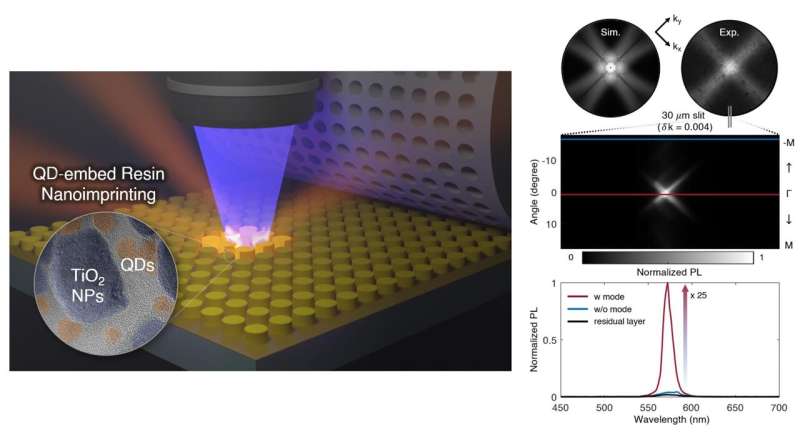
JUNE 12, 2024 by Pohang University of Science and Technology
Collected at: https://phys.org/news/2024-06-method-quantum-dots-metasurfaces-luminescence.html
A study published in Nano Letters demonstrates the use of quantum dots to create metasurfaces, enabling two objects to exist in the same space.
Pohang University of Science and Technology (POSTECH) researchers employed Nanoimprint Lithography (NIL) to fabricate metasurfaces embedded with quantum dots, enhancing their luminescence efficiency. The team included Professor Junsuk Rho from the Department of Mechanical Engineering, the Department of Chemical Engineering, and the Department of Electrical Engineering, Ph.D. candidates Minsu Jeong, Byoungsu Ko, and Jaekyung Kim from the Department of Mechanical Engineering, and Chunghwan Jung, a Ph.D. candidate, from the Department of Chemical Engineering.
NIL, a process for creating optical metasurfaces, utilizes patterned stamps to quickly transfer intricate patterns at the nanometer (nm) scale. This method offers cost advantages over electron beam lithography and other processes. It has the advantage of enabling the creation of metasurfaces using materials that are not available in conventional processes.
Metasurfaces have recently been the focus of extensive research for their ability to control the polarization and emission direction of light from quantum dots.
Quantum dots, which are nanoscale semiconductor particles, are highly efficient light emitters capable of emitting light at precise wavelengths. This makes them widely used in applications such as QLEDs and quantum computing. However, conventional processes cannot embed quantum dots within metasurfaces.
As a result, research has often involved fabricating metasurfaces and quantum dots separately and then combining them, which imposes limitations on controlling the luminescence of the quantum dots.
In this study, the researchers integrated quantum dots with titanium dioxide (TiO2), a material used in the NIL process, to create a metasurface. Unlike conventional methods, which involve separately fabricating the metasurface and quantum dots before combining them, this approach embeds the quantum dots directly within the metasurface during its creation.
The resulting metasurface enhances the proportion of photons emitted from the quantum dots that couple with the resonance mode of the metasurface. This advancement allows for more effective control over the specific direction of light emitted from the quantum dots compared to previous methods.
Experiments demonstrated that the more photons emitted from the quantum dots that were coupled to the resonant modes of the metasurface, the higher the luminescence efficiency. The team’s metasurface achieved up to 25 times greater luminescence efficiency compared to a simple coating of quantum dots.
Professor Rho, who led the research, said, “The use of luminescence-controlled metasurfaces will enable sharper, brighter displays and more precise, sensitive biosensing. Further research will allow us to control luminescence more effectively, leading to advances in areas such as nano-optical sensors, optoelectronic devices, and quantum dot displays.”
More information: Minsu Jeong et al, Printable Light-Emitting Metasurfaces with Enhanced Directional Photoluminescence, Nano Letters (2024). DOI: 10.1021/acs.nanolett.4c00871
Journal information: Nano Letters

Leave a Reply